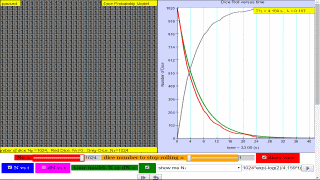About
Translations
| Code | Language | Translator | Run | |
|---|---|---|---|---|
 |
||||
Software Requirements
| Android | iOS | Windows | MacOS | |
| with best with | Chrome | Chrome | Chrome | Chrome |
| support full-screen? | Yes. Chrome/Opera No. Firefox/ Samsung Internet | Not yet | Yes | Yes |
| cannot work on | some mobile browser that don't understand JavaScript such as..... | cannot work on Internet Explorer 9 and below |
Credits


 Fu-Kwun Hwang - Dept. of Physics, National Taiwan Normal Univ.; lookang; leongster
Fu-Kwun Hwang - Dept. of Physics, National Taiwan Normal Univ.; lookang; leongster
end faq
Theory
Assume the number of radioactive nucleus is N(t) --- not yet decayed into daughter product.
Each nucleus has the same probability p (p<1) decayed into daughter product.
It means that dN(t)/dt= -p*N(t) , where dN(t) is the number of nucleus decayed into daughter product at time t.
The solution is N(t)=N0 e -pt = N0 e -(ln2/T0.5)) t where N(0) is total number of nucleus at time t.
Each box represent a nucleus.
This applet let you set the probability for a nucleus to decay and watch how the number of decayed nuclei (color changed to RED) increased with time t.
YouTube
Other Resources
- http://weelookang.blogspot.sg/2015/12/ejss-radioactive-decay-model.html lookang's blogpost about this JavaScript version
- http://www.phy.ntnu.edu.tw/ntnujava/index.php?topic=194.0 by Fu-Kwun Hwang original Java version
- http://www.opensourcephysics.org/items/detail.cfm?ID=10576 by Wolfgang Christian similar Java version
end faq
Facebook Social Comments








